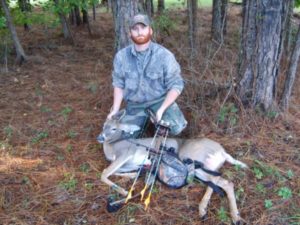
Elevated stands are fantastic deer-hunting tools, but what if you find the perfect ambush location without a climbable tree in sight? That’s when ground blinds come into play, and here are some ideas on making yours the perfect setup.
I’ve been hunting from the ground most of my adult life. Like most hunters in Louisiana, my father put me in a ladder stand made of 2x4s and plywood at a young age, and from that perch, I learned how to watch squirrels, birds and the occasional deer without the fear of being seen.
As time moved forward, however, things began to change, and in the late 1990s, I decided it was time I tried something different: hunting from a ground blind.
As far as I knew, I was the first person in my family who had even dreamed of the notion of hunting eye level with my prey, and my idea was met with a lot of negativity.
“Just won’t work around here,” was the answer family members came up with, as none of them had ever tried hunting from the ground.
But young minds are hard to change, and I was set on the idea of getting up close and personal with a deer.

The first year was tough, but I learned a lot.
My stand was simple: camouflaged burlap tied between three saplings that were spread apart just far enough to accommodate one hunter. plus chicken wire topped with leaves and pine straw for a top.
I wish I had taken pictures of this blind because, looking back, it was near perfect. Near perfect, meaning that it wasn’t — the afternoon sun would throw my shadow against the back wall, and deer could easily see any movement from behind. The mornings, however, were simply amazing. Every time I hunted it, I had deer within 30 yards, and I killed several from the small, primitive hut.
The experience quickly lit my fire for hunting on the ground. My friends have now come to enjoy it as well, and a few of them have made some of the best ground blinds I’ve ever seen for less than a crisp $100 bill.
Establish a reason
Hunting from the ground is extremely enjoyable, but it’s not easy. When you think you’ve found the perfect spot to hunt, the first thing you need to do is try to find an elevated spot from which to hunt.
Hunting from an elevated platform is preferred by hunters because it works so well. Deer have no natural predators that hide in trees, so why would they ever look up? You can hang a lock-on stand in a tree, and even a passing hunter might not see it, but throw a ground blind up and it will stand out like a sore thumb. If someone put a new chair in your living room, you’d notice too, right?
I hunt from the ground when it’s my only choice or when I want a challenge, because it can be extremely difficult. As they say, the hardest things accomplished are the most memorable, and the deer you kill from the ground are usually the ones you’ll always remember.

In 2008, I bowhunted in a pine plantation out of a store-bought ground blind that I’d set up a few months before. The canopy was just too low for an elevated platform; the only option I had was to go low.
It was opening day of muzzleloader season, and the smoke poles were singing all around me, so I knew deer were there. Finally, as the sun crested the pines, I saw a head easing out from my left-side window, and I immediately was on point.
The small spike came in to feed semi-cautiously, but I could tell by its body language that it would settle in if I let it.
Trembling with excitement, I watched it feed for 30 minutes, but eventually I couldn’t stand it anymore. I drew my bow, but when I released I flinched and watched the arrow sail over the deer’s back as it tore out in a cloud of dust.
I was disgusted, but I knew to sit still and nock another arrow.
Ten minutes later, the same head popped up, and I focused on the task at hand. This time when the deer put its head down, the NAP Spitfire went through one side and out the other with ease.
While everyone else was hunting with a gun, I got it done with a stick and string from the ground.
It was hard, trying and tense, but it was a hunt I’ll never forget.
Setting up
This is usually the hardest part of hunting from the ground.
Ideally, I like to set up months in advance and let the animals get used to the blind, but sometimes, that isn’t an option.

When you decide a ground blind is needed, the first thing to do is figure out where to put it. Right off, I look for natural cover to help the stand blend in.
And I’m looking for it in a southern direction. I want the sun to my back at all times for shade and so deer will have the sun in their eyes when looking at the blind.
When I have a stand set up in this position, I feel like I can get away with a little more movement before getting busted by the deer, so facing southeast or the southwest is usually a good idea.
I put this to the test several years ago with a murder of crows that were feeding in my corn at 20 yards. Crows are like ducks; if they see movement they don’t expect, they’re gone in a blink of an eye. I came to full draw on more than 15 crows one sunny morning and they never flinched. I knew then that the sunlight and shadows had done what I hoped.
I do pay attention to the wind, but not nearly as much as one would think. Research has shown that during the early fall, our wind is usually going to come from the east or the south, but it’s never consistent enough to fully bank on. Rarely do you get a north or west wind, unless there is a cool front coming through.
I’d rather have the sun help me here than the wind, because I can choose not to hunt on a day of bad wind instead of having to limit my movement because of the possibility of the sun in my face at some point during my hunt.
Another thing is remember: you will never ever be 100% scent free unless you’re inside a bubble. Instead of trying to be scent free, my theory is to be “scent mixed.”
When I set up my blind, I make sure I have a solid dirt floor — no grass, weeds or leaves under my feet, just soil. I can move around without making a sound, and I can periodically scratch spots on the ground so the soil’s odor is released. It will mix with my scent and, when a deer smells that mix, it makes it harder to pinpoint how close I might be. I also like to grab pine needles and leaves from gum trees as I walk in to my stand. I wad them up in my hands and rub them all over my clothes and body.
When I’m done with them, I don’t throw them on the ground; I stuff them in my pockets, boot and even in my hat. Later in the hunt, I like to refresh them when I’m sure nothing is around.
Brushing-in
Like duck hunting, brushing-in a blind is the most-critical part of hunting from a ground blind. The stand must blend in for the deer to get comfortable and not spook.

After I figure out where to place my blind, I stand back and visualize how I want to brush it in. If there are large trees and saplings in the area, I look for large items to incorporate. If the spot is thick with underbrush, I will look for vines, willow limbs and other material that might be thick with leaves. Pine plantations are a wonderful place to find cover; the limbs will be easy to cut and gather.
I also love to find holly; the limbs seem to work very well, but for only a few days. They die rather quickly, so they soon stand out more than appear covered up.
Also, I pick my brushing material several hundred yards from my stand site: fresh-cut vegetation will raise awareness in any animal passing through that area.
I also like to tuck my stand into a group of trees when possible. The more stuff immediately behind you, the better. Trees all around help break up the round pattern that most store-bought ground blinds have.
Also, look for treetops that have fallen, and try to work your stand into that rubbish. The deer will already be used to that top being down and might pass by without paying it or you any mind.
It’s going to stand out, but the goal of brushing it makes deer more comfortable by providing something that looks a little more natural than a plain ground blind.
Thinking outside the box
Like I said earlier, my first ground blind was burlap and chicken wire, and it was wonderful.
To have a good ground blind, you don’t have to go out and spend a few hundred bucks — you can do it on a budget, if you really take the time and put in some elbow grease.
Farmerville’s John Anderson went all-out in his design of a homemade ground blind in 2013, and what he created was something that was not only practical but was economical, as well.

Anderson calls his blind “The Stump,” and for good reason: it looks like a stump sitting in the woods.
In 2013, he heard from an employee that a local electrical supply company was going to throw away some very large, 8-foot metal wire spools. Always being one to seize an opportunity, Anderson obtained a spool and started making plans for a ground blind. He was planning to hunt from on a creek bank where the tree canopy is very low.
After visiting a local sawmill, he acquired some scrap cypress boards from 2 to 12 inches wide.
“Once I started finding the scrap material, it all started coming together,” Anderson said. “The roof is some plywood and roofing felt that I had and vinyl flooring that someone was going to throw away.
“It works great, so far.”

The Stump is roughly 7 feet tall by 8 feet around and has enough room for four adults.
“It’s almost to the point of being too big, actually,” Anderson said. “I’ve got plans to build one this year that’s 6 feet around to bowhunt from.”
The total cost in the screws, welding rods and sweat equity brought the cost of “The Stump” to roughly $53 — total.


